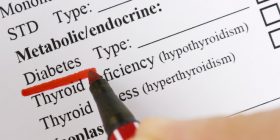The genetics of diabetes – as well as other hereditary components of the disease – are important for you to know. We’ll address the genes involved in type 1 and type 2 diabetes in this article.
What causes diabetes?
Type 1 diabetes is an autoimmune disease. This means that the body’s immune system destroys beta cells in a part of the pancreas called the islet tissue. These beta cells produce insulin, so people with type 1 diabetes can’t make their own insulin. Researchers continue to study what may cause the immune system to act in this way, but at this time there are no definitive answers.
Type 2 diabetes happens when the body is unable to produce enough insulin, or when the insulin that is produced does not work properly (this is called insulin resistance).
Is type 1 diabetes hereditary?
While the cause of type 1 diabetes isn’t currently known, there seem to be some hereditary factors (“hereditary” means something that can be passed on from parents to their children):
- If a man has type 1 diabetes, his child has about a 1 in 17 chance (6%) of getting it.
- For a woman with type 1 diabetes who gives birth to a child:
- Before age 25, the child has a 1 in 25 chance (4%)
- At age 25 and older, the child has 1 in 100 chance (1%)
- If both parents have type 1 diabetes, the odds for their children could be as high as 1 in 4 (25%)
- If your parents don’t have type 1 diabetes, but your brother or sister does, you have a 1 in 20 chance (5%) of getting the disease
What genes are involved in type 1 diabetes?
The genes involved in type 1 diabetes are the “HLA” genes, which stands for human leukocyte antigen complex. These genes provide instructions for making proteins that play a critical role in the immune system. As well, HLA genes help the body’s immune system distinguish its own proteins from proteins made by foreign invaders (for example, viruses and bacteria).
There are thousands of versions of HLA genes in the human gene pool. Which ones you get from your parents greatly affect your risk for type 1 diabetes. Some make you more likely to get it, while others can actually help protect you from it. The bottom line is that, for unknown reasons, people who have inherited certain HLA genes from their parents have a higher risk for type 1 diabetes
Is type 2 diabetes hereditary?
Type 2 diabetes is definitely hereditary. In fact, one of the biggest risk factors for type 2 diabetes is having a close relative with the disease, such as a parent, or a brother or sister. The risk increases with the number of family members who have it:
| Family history | Chance of developing diabetes |
| If one of your parents was diagnosed before age 50 | 1 in 7 chance (14%) |
| If one of your parents was diagnosed after the age of 50 | 1 in 13 chance (8%) |
| If both your parents have diabetes, | 1 in 2 chance (50%) |
What genes are involved in type 2 diabetes?
The genes associated with the risk of type 2 diabetes include:
| Gene | What it does |
| TCF7L2 | which affects insulin secretion and glucose production |
| ABCC8 | which helps regulate insulin |
| CAPN10 | which is associated with type 2 diabetes risk in Latin-American populations |
| GLUT2 | which helps move glucose into the pancreas |
| GCGR | a glucagon hormone involved in glucose regulation |
Tests are available for some of the gene mutations associated with type 2 diabetes. However, the increased risk for any given mutation is small. Other factors are far more accurate predictors of whether you’ll develop type 2 diabetes, including:
- Being over 40 years of age
- Being overweight
- Having high blood pressure or high cholesterol levels
- Having a history of gestational diabetes
- Being of certain ethnicities (for example, Aboriginal, Hispanic, South Asian, Asian or African)
Is my child at risk for diabetes?
If you have type 1 or type 2 diabetes your children may be at a higher risk for having the condition. Because type 1 diabetes is an autoimmune disease, there is currently nothing that can be done to alter this risk.
However, for children who have a family history of type 2 diabetes, there are some things that can be done to reduce their risk of getting the disease. These include getting regular physical activity, maintaining a healthy weight (or losing weight, if needed) and eating healthy foods.
 Diabetes Care Community Learn, connect and care
Diabetes Care Community Learn, connect and care





